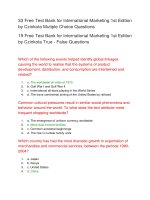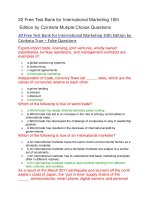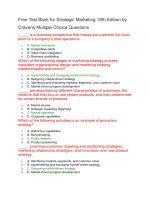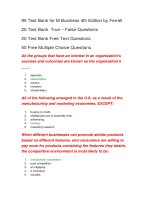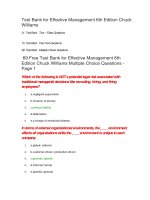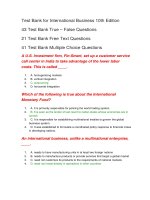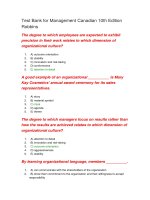105 test bank for international business 10th edition
Bạn đang xem bản rút gọn của tài liệu. Xem và tải ngay bản đầy đủ của tài liệu tại đây (149.94 KB, 26 trang )
Test Bank for International Business 10th Edition
43 Test Bank True – False Questions
21 Test Bank Free Text Questions
41 Test Bank Multiple Choice Questions
A U.S. Investment firm, Fin-Smart, set up a customer service
call center in India to take advantage of the lower labor
costs. This is called ____.
1.
2.
3.
4.
A. homogenizing markets
B. vertical integration
C. outsourcing
D. horizontal integration
Which of the following is true about the International
Monetary Fund?
1.
2.
A. It is primarily responsible for policing the world trading system.
B. It is seen as the lender of last resort to nation-states whose economies are in
turmoil.
3. C. It is responsible for establishing multinational treaties to govern the global
business system.
4. D. It was established to formulate a coordinated policy response to financial crises
in developing nations.
An international business, unlike a multinational enterprise,
____.
1.
2.
3.
4.
A. needs to have manufacturing units in at least two foreign nations
B. needs to manufacture products or provide services that target a global market
C. need not customize its products to the requirements of national markets
D. need not invest directly in operations in other countries
Which of the following is NOT an impediment that makes it
difficult for firms to achieve the optimal dispersion of
their productive activities to locations around the
globe?
1.
2.
3.
4.
A. Reduced tariffs on imports of manufactured goods
B. Government regulations
C. Issues associated with economic and political risk
D. Barriers to foreign direct investment
Which of the following is NOT included in world merchandise
trade?
1.
2.
3.
4.
A. Manufactured goods
B. Agricultural goods
C. Services
D. Mining products
_____ predicts that the power of microprocessor technology
doubles and its cost of production falls in half every 18
months.
1.
2.
3.
4.
A. Keynes's Law
B. Say's Law
C. Moore's Law
D. Sullivan Principles
Containerization allows:
1.
2.
3.
4.
A. reduction of the time needed to get from one location to another.
B. simplification of transshipment from one mode of transport to another.
C. buyers and sellers to find each other easily.
D. enterprises to coordinate and control a globally dispersed production system.
A number of econometric studies have found consistent
evidence of a hump-shaped relationship between
income levels and pollution levels. According to this,
as an economy grows and income levels rise:
1.
2.
3.
4.
A. initially the pollution levels remain low
B. after a while the pollution levels decrease
C. the pollution levels also rise in proportion to the economic growth
D. there is increasing industrialization which leads to greater pollution
Which of the following countries has been the largest
recipient of foreign direct investment and received
about $60 billion to $100 billion a year in inflows in
2004-2009?
1.
2.
3.
4.
A. Brazil
B. Russia
C. India
D. China
Which of the following factors hinders globalization of
consumer goods market?
1.
2.
A. National differences in tastes and preferences
B. Higher production costs in developed nations
3.
4.
C. Homogenization of material culture
D. Increasing outsourcing of goods and services
A multinational enterprise (MNE) is a firm that ____.
1.
2.
3.
4.
A. exports its products to multiple countries
B. has production units in more than two countries
C. does most of its business on the Internet
D. lists its securities on a public exchange
_____ have/has the most to gain from reductions in
agricultural tariffs and subsidies that are a part of the
Doha agenda.
1.
2.
3.
4.
A. The world's developed nations
B. The world's poorer nations
C. European nations
D. The United States
Which of the following is NOT a consequence of the
reduction in trade barriers and restrictions on FDI
since 1950?
1.
A. Firms are dispersing parts of their production process to global locations to
drive down production costs and increase product quality.
2. B. The economies of the world's nation states are becoming more intertwined.
3. C. Nations are becoming more independent of each other for important goods and
services.
4. D. The world has become significantly wealthier since 1950.
Throughout the 1990s, the amount of foreign direct
investment directed at both developed and developing
nations increased dramatically. This trend reflects:
1.
2.
3.
4.
A. a slowdown in global economic activity.
B. the increasing share of the U.S. in the total FDI stock.
C. the decline in cross-border flows of foreign direct investment.
D. the increasing internationalization of business corporations.
Which of the following is a risk associated with
globalization?
1.
2.
3.
4.
A. Restrictions on competition
B. Global financial contagion
C. Excessive market regulation
D. Differentiation of markets
The G20 was originally established to ____.
1.
2.
A. preserve peace through international cooperation and collective security
B. maintain order in the international monetary system
3.
C. formulate a coordinated policy response to financial crises in developing
nations
4. D. manage, regulate, and police the global marketplace
Which of the following is a consequence of globalization?
1.
2.
3.
4.
A. Decreasing interdependence between national economies
B. Increasing outsourcing of services
C. Differentiation of material culture
D. Increase in barriers to cross-border trade
In the last two decades, Latin American countries like Brazil,
Mexico, and Chile have ____.
1.
2.
3.
4.
A. embraced communist principles
B. promoted government ownership of enterprises
C. experienced increasing debt and inflation
D. welcomed foreign investment
Globalization is criticized because it increases the power of
____.
1.
2.
3.
4.
A. governments to own enterprises
B. unskilled labor to form labor unions
C. supranational organizations over nation-states
D. nation-states to regulate markets and reduce competition
Supporters of globalization maintain that the apparent
decline in real wage rates of unskilled workers:
1.
2.
3.
4.
A. is due to technological changes that create greater demand for skilled workers.
B. is due to the migration of low-wage manufacturing jobs offshore.
C. can be checked by increasing government ownership of enterprises.
D. can be checked by limiting free trade and foreign investment.
A study published in 2011 by the OECD noted that:
1.
A. the real household income of the unskilled workers in the U.S. increased more
in comparison to that of the skilled workers.
2. B. in almost all countries real income levels declined over the 20-year period
studied.
3. C. falling unemployment rates brought gains to low-wage workers and fairly broadbased wage growth.
4. D. the gap between the poorest and richest segments of society in some OECD
countries had widened.
What is the total cumulative value of foreign investments
best referred to as?
1.
2.
3.
A. Accumulation of foreign shares
B. Portfolio investments
C. Stock of foreign direct investments
4.
D. Stock market investments
Early outsourcing efforts were primarily confined to ____.
1.
2.
3.
4.
A. health care
B. service activities
C. technological research
D. manufacturing activities
_____ occurs when a firm exports goods or services to
consumers in another country.
1.
2.
3.
4.
A. International trade
B. Foreign direct investment
C. Inward investment
D. Outsourcing
NAFTA was passed only after:
1.
2.
3.
A. China agreed to establish a higher minimum wage.
B. the U.S. agreed to limit the number of jobs that could be outsourced.
C. Mexico committed to tougher enforcement of environmental protection
regulations.
4. D. Canada committed to establish new limits on FDI.
The World Trade Organization promotes ____.
1.
2.
3.
4.
A. lowering of barriers to cross-border trade and investment
B. infrastructural development in poor nations through low-interest loans
C. state ownership of major enterprises
D. regulation of national economies
The World Trade Organization has estimated that the
developed nations of the world can raise global
economic welfare by $128 billion by:
1.
2.
3.
4.
A. removing subsidies given to their agricultural producers.
B. increasing tariff barriers to trade in agriculture.
C. increasing outsourcing of manufacturing processes.
D. reducing defense expenditure.
What is the main reason that managing an international
business differs from managing a domestic business?
1.
2.
3.
4.
A. Because international managers are more experienced.
B. Because countries differ in their cultures and systems.
C. Because countries want to do business with their neighbors.
D. Because countries want to keep their transactions simple.
Which of these statements pertaining to cross-border FDI
flows is true?
1.
2.
3.
4.
A. There was a growth of FDI between 2004 and 2007.
B. A slump in FDI from 1998 to 2000 was followed by a surge from 2001 to 2003.
C. Among developing nations, the largest recipient of FDI has been Russia.
D. The dramatic increase in FDI reflects the decreasing internationalization of
business corporations.
Since the 1960s, which of the following has been a notable
trend in the demographics of the multinational
enterprise?
1.
2.
3.
4.
A. The decline of multinational companies in the manufacturing sector
B. The growth of government-owned multinational enterprises
C. The decline of non-U.S. multinationals
D. The growth of mini-multinationals
Globalization of markets results in markets becoming ____.
1.
2.
3.
4.
A. less interdependent
B. less diverse
C. more protected
D. less competitive
In late 2001, the WTO launched a new round of talks in Doha
aimed at:
1.
2.
3.
4.
A. helping member states to cope with financial crisis.
B. further liberalization of the global trade and investment framework.
C. protecting national economies from global competition.
D. promoting higher standards of living in all member states.
Since the collapse of communism at the end of the 1980s,
the erstwhile communist nations have transformed
their economies by globalizing their markets. This
involves ____.
1.
2.
3.
4.
A. regulating markets
B. privatizing state-owned enterprises
C. decreasing competition
D. reducing foreign investment
The ______ is primarily responsible for policing the world
trading system and making sure nation-states adhere
to the rules laid down in trade treaties signed by
member states.
1.
A. International Development Association
2.
3.
4.
B. World Bank
C. International Court of justice
D. World Trade Organization
The General Agreement on Tariffs and Trade (GATT) was
responsible for ____.
1.
2.
3.
4.
A. protecting government owned enterprises
B. policing the global marketplace
C. limiting nuclear testing
D. promoting environment friendly technology
The financial crisis in the U.S. in 2009 was triggered by ____.
1.
2.
3.
4.
A. the global hike in the price of crude oil
B. the slowdown in U.S. imports
C. the problems in the U.S. subprime mortgage lending market
D. the artificial fixing of currency rate by China
The _____ was established on October 24, 1945, by 51
countries committed to preserving peace through
international cooperation and collective security.
1.
2.
3.
4.
A. World Trade Organization
B. United Nations
C. G20
D. World Bank
In the 1970s, many Japanese firms invested in North America
and Europe:
1.
2.
3.
4.
A. to avoid a highly competitive domestic market.
B. to exploit high domestic tariff barriers.
C. as a hedge against unfavorable currency movements.
D. to take advantage of low labor costs.
The relative decline of the United States in the share of world
output and world exports reflects ____.
1.
2.
3.
4.
A. an increase in the barriers to foreign trade in the U.S.
B. the deepening of the global financial crisis
C. the reduced industrialization in developing nations
D. the growth in the economic development of the world economy
Which of the following has enabled globalization of
markets?
1.
2.
3.
4.
A. Differentiation amongst national markets
B. Falling barriers to cross border trade
C. Reduced homogeneity of material culture across the world
D. Increased government ownership of factors of production
Which of the following statements is true about an
international business?
1.
A. An international business needs to invest directly in operations in other
countries.
2. B. An international business needs to have homogenous practices across
countries.
3. C. An international business can be managed in the same way that a domestic
business is managed.
4. D. An international business must find ways to work within the limits imposed by
government intervention.
43 Free Test Bank for International Business 10th
Edition by HillTrue - False Questions
Non-U.S. firms increasingly began to invest across national
borders because they wanted to disperse production
activities to optimal locations and to build a direct
presence in major foreign markets.
1.
2.
True
False
Globalization reduces the risks of global financial contagion.
1.
2.
True
False
Outsourcing is a process that is limited to manufacturing
enterprises.
1.
2.
True
False
Over the past 30 years the flow of FDI has accelerated faster
than the growth in world trade and world output.
1.
2.
True
False
One of the UN's central mandates is the promotion of higher
standards of living, full employment, and conditions of
economic and social progress and development.
1.
2.
True
False
According to critics of globalization, today's interdependent
global economy limits a nation's national sovereignty.
1.
True
2.
False
In 2008 and 2009, the GATT became the forum though which
major nations attempted to launch a coordinated
policy response to the global financial crisis, which
started in America.
1.
2.
True
False
According to WTO data, the volume of world merchandise
trade has grown faster than the world economy since
1950.
1.
2.
True
False
Cross-border business transactions have become easier for
international businesses because they use a common
currency.
1.
2.
True
False
A multinational enterprise (MNE) is any business that
exports or imports products from other countries.
1.
2.
True
False
According to supporters of free trade, as countries get richer
they commit greater violation of environmental and
labor regulations.
1.
2.
True
False
Globalization of markets has resulted in greater
differentiation of consumer tastes and preferences.
1.
2.
True
False
A current trend in international business is the decline of
medium-sized and small multinationals, known as
mini-multinationals.
1.
2.
True
False
The Uruguay Round, finalized in December 1993, reduced
protection for patents, trademarks, and copyrights.
1.
2.
True
False
The most global markets currently are markets for consumer
products.
1.
2.
True
False
Doing business in Russia involves risks because the country
has shown signs of shifting back toward greater state
involvement in economic activity and authoritarian
government.
1.
2.
True
False
Supporters of debt relief argue that new democratic
governments in poor nations should not be forced to
honor debts incurred by corrupt and dictatorial
predecessors.
1.
2.
True
False
The World Bank has focused on policing the world trading
system and making sure nation-states adhere to the
rules laid down in trade treaties.
1.
2.
True
False
Current trends indicate the world is moving toward an
economic system that is more favorable for
international business.
1.
2.
True
False
A domestic business must find ways to work within the
limits imposed by governmental intervention in the
international trade and investment system.
1.
2.
True
False
The World Bank is known as the lender of the last resort.
1.
2.
True
False
Rivers Inc., a U.S. based sports apparel manufacturer, sets
up a production unit in China to take advantage of the
lower labor costs there. This is an example of foreign
direct investment.
1.
2.
True
False
"Beggar thy neighbor" retaliatory trade policies involved
countries progressively lowering trade barriers against
each other, which contributed to the Great Depression
of the 1930s.
1.
2.
True
False
Managing an international business is much easier than
managing a domestic business.
1.
2.
True
False
In the early 1960s, the United States was by far the world's
dominant industrial power. However by 2009, it lost its
dominant position and now, is no longer the world's
largest industrial power.
1.
2.
True
False
Evidence suggests that technological change has had a
bigger impact than globalization on the declining share
of national income enjoyed by labor.
1.
2.
True
False
The cost of microprocessors continues to fall, while their
power increases. This statement supports the
predictions made by Moore's Law.
1.
2.
True
False
Companies hope to lower their overall cost structure or
improve the quality or functionality of their product
offering through globalization of production.
1.
2.
True
False
The Internet has developed into the information backbone of
the global economy.
1.
2.
True
False
Efficiency gains associated with containerization have
caused transportation costs to fall dramatically.
1.
2.
True
False
Globalization critics argue that the decline in unskilled wage
rates is due to the migration of low-wage
manufacturing jobs offshore and a corresponding
reduction in demand for unskilled workers.
1.
2.
True
False
The shift toward a more integrated and interdependent world
economy is referred to as globalization.
1.
2.
True
False
Critics of globalization suggest that over the last century, the
gap between the rich and poor nations of the world
has shrunken.
1.
2.
True
False
The globalization of markets and production and the
resulting growth of world trade, foreign direct
investment, and imports all imply that firms are finding
their home markets protected from foreign
competitors.
1.
2.
True
False
Recent evidence indicates that the solution to the problem of
stagnant incomes among the unskilled is to be found
in increasing government regulation of markets.
1.
2.
True
False
A firm does not have to become a multinational enterprise to
engage in international business.
1.
2.
True
False
The globalization of the world economy has resulted in a
relative increase in the dominance of U.S. firms in the
global marketplace.
1.
2.
True
False
World Bank gives an aid of 100 million dollars to Kenya for
creating rural health care facilities. This is an example
of foreign direct investment.
1.
2.
True
False
The health care sector in the U.S. cannot avail the benefits of
outsourcing to low-cost producers in other nations
because of the nature of the work.
1.
2.
True
False
The expansion of world trade implies that nations are
becoming less dependent on each other for important
goods and services.
1.
2.
True
False
Differences between countries require that an international
business vary its practices country by country.
1.
2.
True
False
The lowering of barriers to international trade enables firms
to view the world, rather than a single country, as their
market.
1.
2.
True
False
A company does not need a large size to facilitate, and
benefit from, the globalization of markets.
1.
2.
True
False
21 Free Test Bank for International Business 10th
Edition by Hill Free Text Questions
How has the foreign direct investment picture changed since
the 1960s?
Answer Given
The U.S. accounted for about 66.3 percent of worldwide foreign direct investment
flows in the 1960s, followed by British firms with about 10.5 percent of FDI flows,
and Japanese firms with 2 percent. As barriers to trade fell, non-U.S. firms
increased their investments around the world in search of optimal production
locations and a direct presence in major markets. During the 1990s, FDI to both
developed and developing nations increased dramatically. China also emerged as
an important destination for FDI.
Falling barriers to international trade destroy manufacturing
jobs in wealthy advanced economies. Discuss this
statement. Do you agree? Why or why not?
Answer Given
Critics argue that falling trade barriers allow firms to move manufacturing activities
to countries where wage rates are much lower. Because of such moves they
argue that, the wage rates of poorer Americans have fallen significantly over the
past quarter of a century. Supporters of globalization reply that critics of these
trends miss the essential point about free trade—the benefits outweigh the costs.
They argue that free trade will result in countries specializing in the production of
those goods and services that they can produce most efficiently, while importing
goods and services that they cannot produce as efficiently.
Explain the notion of the Internet emerging as an equalizer.
Answer Given
In 1990, fewer than 1 million users were connected to the Internet. By 1995, the
figure had risen to 50 million. By 2012 the Internet had 2.4 billion users. Viewed
globally, the Internet is emerging as an equalizer. It rolls back some of the
constraints of location, scale, and time zones. The Internet makes it much easier
for buyers and sellers to find each other, wherever they may be located and
whatever their size. It allows businesses, both small and large, to expand their
global presence at a lower cost than ever before. It enables enterprises to
coordinate and control a globally dispersed production system in a way that was
not possible 20 years ago.
What is the Uruguay Round? List the measures implemented
in the Uruguay Round?
Answer Given
Under the umbrella of GATT, eight rounds of negotiations among member states
worked to lower barriers to the free flow of goods and services. The most recent
negotiations to be completed, known as the Uruguay Round, were finalized in
December 1993. The Uruguay Round further reduced trade barriers; extended
GATT to cover services as well as manufactured goods; provided enhanced
protection for patents, trademarks, and copyrights; and established the World
Trade Organization to police the international trading system.
Explain how a company competes using outsourcing.
Provide an example.
Answer Given
The lowering of trade and investment barriers also allows firms to base production
at the optimal location for that activity. Thus, a firm might design a product in one
country, produce component parts in two other countries, assemble the product in
yet another country, and then export the finished product around the world. For
example, consider Boeing's 777, a commercial jet airliner. Eight Japanese
suppliers make parts for the fuselage, doors, and wings; a supplier in Singapore
makes the doors for the nose landing gear; three suppliers in Italy manufacture
wing flaps; and so on. In total, some 30 percent of the 777, by value, is built by
foreign companies.
What are some of the issues a manager of an international
business must confront that a manager of a domestic
business never confronts?
Answer Given
In addition to the problems that arise from the differences between countries,
managers of an international business must decide where in the world to site
production activities to minimize costs and to maximize value added. They must
decide whether it is ethical to adhere to the lower labor and environmental
standards found in many less developed nations. Then they must decide how best
to coordinate and control globally dispersed production activities, which is not a
trivial problem. Managers in an international business must also decide which
foreign markets to enter and which ones to avoid.
Discuss the demographics of world trade since the 1960s.
How has the role of the U.S. changed? How is world
trade expected to change in the future?
Answer Given
In the early1960s, the U.S. was the world's dominant industrial power accounting
for over 40 percent of world output. By 2009, the United States accounted for 24.1
percent of world output, still the world's largest industrial power but down
significantly in relative size since the 1960s. Other industrialized countries also
saw their relative standing slip. This change in the U.S. position was a relative
decline, reflecting the faster economic growth of several other economies,
particularly in Asia. Most forecasts now predict a rapid rise in the share of world
output accounted for by developing nations such as China, India, Russia,
Indonesia, Thailand, South Korea, Mexico, and Brazil, and a commensurate
decline in the share enjoyed by rich industrialized countries such as Great Britain,
Germany, Japan, and the United States.
Discuss the impact of technological change on global
markets.
Answer Given
Major advances in communication, information processing, and transportation
technology have facilitated the globalization of markets and production. The
microprocessor and the Internet have been central to the technology explosion.
The development of the microprocessor vastly increased the amount of
information that can be processed by individuals and firms, and the growth of the
Internet has allowed companies to expand their global presence at a fraction of
the cost of more traditional methods of business. Jet air travel, by shrinking travel
time, has also helped to link the worldwide operations of international businesses.
These changes have enabled firms to achieve tight coordination of their worldwide
operations and to view the world as a single market.
Consider the global economy of the 21st century. What
important changes are taking place? What do these
changes mean for international companies?
Answer Given
The last 25 years have been a time of great change in the global economy.
Barriers to the free flow of goods, services, and capital have been falling, national
economies are becoming more integrated, and more countries are joining the
ranks of the developed world. All of these changes point toward an economic
system that is more favorable for international business.
What is a multinational enterprise (MNE)? How does a minimultinational differ from an MNE?
Answer Given
A multinational enterprise is any business that has productive activities in two or
more countries. Since the 1960s, two notable trends in the demographics of the
multinational enterprise have been (1) the rise of non-U.S. multinationals and (2)
the growth of mini-multinationals. The number of mini-multinationals is also on the
rise. Mini-multinationals are medium-sized and small MNEs.
Explain what is meant by the globalization of markets.
Provide an example. What are the most global
markets?
Answer Given
The globalization of markets refers to the idea that historically distinct and
separate national markets are merging into a single, huge global marketplace. For
example, Coca-Cola, Starbucks, and McDonald's offer the same basic product
worldwide, and are in fact, not only a part of the trend, but facilitators of the trend
as well. The most global markets are not actually for consumer goods, but instead
are for industrial goods and materials that serve the same needs across the world.
Innovations in transportation have had a major impact on
global trade. Consider one of these innovations:
containerization. Why is this innovation so significant?
Answer Given
Containerization has revolutionized the transportation business, significantly
lowering the costs of shipping goods over long distances. Since 1980, the world's
containership fleet has more than quadrupled, reflecting in part the growing
volume of international trade and in part the switch to this mode of transportation.
As a result of the efficiency gains associated with containerization, transportation
costs have plummeted, making it much more economical to ship goods around the
globe, thereby helping to drive the globalization of markets and production.
What is the World Trade Organization? What is its role in the
world economy?
Answer Given
The World Trade Organization (WTO) is primarily responsible for policing the
world trading system and making sure nation-states adhere to the rules laid down
in trade treaties signed by WTO members. The WTO currently has 148 members
that collectively account for 97 percent of world trade. The WTO has been
instrumental in lowering barriers to cross-border trade and investment. In addition
to these responsibilities, the WTO also facilitates the establishment of additional
agreements between member states.
Discuss the concept of the globalization of production.
Answer Given
The globalization of production refers to the sourcing of goods and services from
locations around the globe to take advantage of national differences in the cost
and quality of factors of production (such as labor, energy, land, and capital). By
doing this, companies hope to lower their overall cost structure or improve the
quality or functionality of their product offering, thereby allowing them to compete
more effectively.
Why does China represent both opportunities and threats for
established international businesses?
Answer Given
China represents a huge and largely untapped market. Reflecting this, between
1983 and 2010, annual foreign direct investment in China increased from less than
$2 billion to $100 billion annually. On the other hand, China's new firms are
proving to be very capable competitors, and they could take global market share
away from Western and Japanese enterprises. Thus, the changes in China are
creating both opportunities and threats for established international businesses.
Why is managing an international business different from
managing a purely domestic business?
Answer Given
Managing an international business is different from managing a purely domestic
business for at least four reasons: (1) countries are different, (2) the range of
problems confronted by a manager in an international business is wider and the
problems themselves more complex than those confronted by a manager in a
domestic business, (3) an international business must find ways to work within the
limits imposed by government intervention in the international trade and
investment system, and (4) international transactions involve converting money
into different currencies.
Consider whether the shift toward a more integrated and
interdependent global economy is a good thing.
Discuss the shift from the eyes of the consumer, the
worker, the company, and the environmentalist.
Answer Given
There are many advantages of globalization. From a broad perspective,
globalization creates economic activity (which stimulates economic growth),
creates jobs, raises income levels, and provides consumers with more choices in
regard to the products and services that are available to them. From the
perspective of an individual firm, globalization has the potential to increase
revenues (through expanded market potential), drive down costs (through
additional economies of scale), and boost profits. However, critics argue that
globalization destroys manufacturing jobs in wealthy countries and contributes to
pollution. Critics argue that falling trade barriers allow firms in industrialized
countries to move their manufacturing activities offshore to countries where wage
rates are much lower. Critics also argue that globalization encourages firms from
advanced nations to move manufacturing facilities offshore to less developed
countries to avoid the more stringent pollution controls in place in their home
countries.
Discuss what occurred in Seattle in 1999 at the meeting of
the WTO and why the events were important to the
future of global trade.
Answer Given
In December 1999, more than 40,000 protesters blocked the streets of Seattle in
an effort to shut down a WTO meeting being held in the city. The issue was job
losses in industries under attack from foreign competitors, falling wage rates of
unskilled workers, environmental degradations, and cultural imperialism of global
media and MNEs. Protesters believed that all of these issues were the result of
globalization, and felt that the WTO, as a promoter of globalization, was a
legitimate target for blame. The protest was a violent one, and emboldened by the
experience, antiglobalization protesters now turn up at almost every major meeting
of a global institution.
Explain the trends in world trade and foreign direct
investment over the last half century.
Answer Given
Since 1950, the volume of world merchandise trade has grown faster than the
world economy. In particular, there has been acceleration in world trade since
1980. This trade and investment pattern implies that firms are dispersing parts of
their production to different locations around the world to drive down production
costs and increase product quality, that the economies of the world's nation states
are becoming more intertwined, that foreign direct investment is playing an
increasing role in the global economy as firms increase their cross-border
investments, and that the world has become significantly wealthier over the last 50
years.
What is the International Monetary Fund? What is the World
Bank? What is their relationship, if any, with each
other?
Answer Given
The International Monetary Fund (IMF) was created to maintain order in the
international monetary system. The World Bank was established to promote
economic development. Both organizations were launched as part of the 1944
Bretton Woods Agreement, and have emerged as significant players in the global
economy. The IMF is often seen as the lender of last resort to nation-states whose
economies are in turmoil and currencies are losing value against those of other
nations.
With the help of an example discuss the characteristics of
globalization.
Answer Given
Globalization refers to a fundamental shift in the world economy in which national
economies are no longer relatively self-contained entities. Instead, nations are
moving toward an interdependent global economic system. Within this new global
economy, an American might drive to work in a car designed in Germany that was
assembled in Mexico by DaimlerChrysler from components made in the U.S. and
Japan that were fabricated from Korean steel and Malaysian rubber. A company
does not have to be the size of these multinational giants to facilitate, and benefit
from, the globalization of markets.

